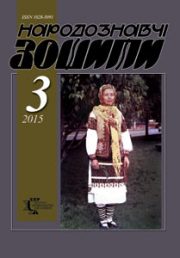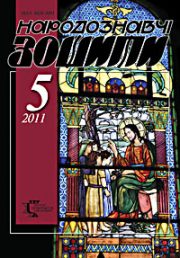The Ethnology Notebooks. 2021. № 5 (161), 1035—1041
UDK 39:930(477.83+477.87=161.2)”07/11″
DOI https://doi.org/10.15407/nz2021.05.1035
NECROPOLISES OF ANCIENT PLISNESK IN THE CONTEXT OF ETHNOCULTURAL AND STATE-BUILDING PROCESSES
FYLYPCHUK Halyna
- ОRCID ID: https://orcid.org/ 0000-0002-2768-6706
- the Department of Historical Ethnology,
- 15, Svobody Avenue, 79000, Lviv, Ukraine,
- Contacts: e-mail: galsoloviy@ukr.net
FYLYPCHUK Andrij
- ОRCID ID: https://orcid.org/0000-0002-2717-8234
- Deputy Research Director,
- Communal Institution of Lviv Regional Council
- «Administration of Historical
- and Cultural Reserve «Ancient Plisnesk»,
- 54, V. Lypynsky St., Lviv, 79024, Lviv, Ukraine,
- Contacts: e-mail: archandrij@ukr.net
Abstract. Based on archaeological materials, the article highlights the nature of the necropolises of ancient Plisnesk of the 9—13th centuries. The main purpose of the publication is to explore the question of the evolution of the funeral rite of the local population through the prism of ethnocultural and state-building processes.
It was found that soil cremations of the 9—10th centuries represented traditional Slavic burials. In the archeological excavations, it was even possible to find the remains of a pagan building for the cremation of the dead, unique for Plisnesk. Later mounds of the 11—12th centuries appeared with the inclusion of our lands in Rus’ (after the Rus-Croatian war of 993). In general, burials under earthen mounds are represented by cremations and inhumations. Traces of coofinswere also found, and the graves sometimes contained a rich accompanying inventory (jewelry, household items, weapons, etc.). The mound rite in Plisnesk was started by the Vikings, and later their Slavicized descendants, and possibly representatives of the indigenous population, were buried on the burial ground. Mass laying of Christian cemeteries in the 12—13th centuries was also due to the active state-building processes. Burials were typical of the Christian custom of the time, without inventory, erected on the back of the body, facing the west. However, when the funeral rite changed, the same population ramained, only its religious and ideological orientations changed.
The research methodology is based on the general scientific principles of systematics, objectivity and historicism, as well as on the theoretical analysis of archaeological explication.
Keywords: Plisnesk, necropolises, burials, Slavs, Vikings, ethnocultural and state-building processes.
Received 1.08.2021
REFERENCES
- Fylypchuk, M. (2015). Plisnensk Archaeological Complex: Theory and Practice of Research. Bulletin of the Institute of Archeology (Issue 10, pp. 38—64) [in Ukrainian].
- Fylypchuk, M., & Fylypchuk, A. (2017). Plisnesk settlement in the light of new research. Plisnesk antiquities (Issue 2, pp. 7—17) [in Ukrainian].
- Fylypchuk, M., & Shuj, N. (2006). Cemeteries Plisnesk archaeological complex as a source for the study of ethnocultural mikro regional level. Bulletin of the Institute of Archeology (Issue 1, pp. 71—85) [in Ukrainian].
- Fylypchuk, M., & Solovii G. (2014). Funerary monuments of Slavic time of the Plisnesk archaeological complex. Studia Mythologica Slavica (Vol. 17, pp. 37—56) [in Ukrainian].
- Fylypchuk, A. (2019). Ancient Christian Plisnesk. Lviv [in Ukrainian].
- Liwoch, R. (2012). To the problem of the beginnings of the church in Western Rus. Archaeological research of Lviv University (Issue 16, pp. 130—136) [in Ukrainian].
- Liwoch, R. (2007). Great burial mounds of the Plisnesk chronograph. Materials and research on the archeology of Prykarpattia and Volyn (Issue 11, pp. 367—378) [in Polish].
- Fylypchuk, M. (2004). Rescue archeological works in the chronicle of Plisnesk in 2001, 2003. Archaeological discoveries in Ukraine, 2002—2003 (Pp. 328—333) [in Ukrainian].
- Fylypchuk, M.A. (2009). Research Plisnesk archaeological complex in 2007. Bulletin of the Institute of Archeology (Issue 4, pp. 130—176) [in Ukrainian].
- Liwoch, R., & Wykopaliska, T. (2008). Ziemiecki in Grodzisk in Podhorce. Ancient Iskorosten and Slavic cities (Vol. 2, pp. 4—8) [in Polish].
- Fylypchuk, H., & Fylypchuk, M. (2016). On the question of the chronology of the Plisnesk mound cemetery. Plisnesk antiquities. Collection of scientific works of the Administration of the Historical and Cultural Reserve «Ancient Plisnesk» in honor of Mykhail Andriiovych Fylypchuk (Pp. 277—279) [in Ukrainian].
- Fylypchuk, H.V. (2016). New materials for the study of Christian cemeteries in Plisnesk. Bulletin of the Institute of Archeology (Issue 11, pp. 187—197) [in Ukrainian].
- Fylypchuk, A.M. (2018). Ancient Plisnesk: history and myths. Lviv [in Ukrainian].
- Mykhailyna, L. (2000). East Slavic cemetery at the end of the 1st millennium AD near the village Revne on the Prut. Questions of ancient and medieval history, archeology and ethnology (Vol. 2, pp. 81—90) [in Ukrainian].
- Yahodynska, M. (1994). Slavic cemetery near Stary Zbarazh. Dzherelo (Issue 1, pp. 137—153) [in Ukrainian].
- Baran, V.D. (1998). Ancient Slavs. Kyiv [in Ukrainian].
- Fylypchuk, M.A. (2009). The structure of the Plisnesk archeological complex in Slavic and Old Rus times. Bulletin of the Institute of Archeology (Issue 4, pp. 3—21) [in Ukrainian].
- Tomenchuk, B. (2006). Archeology of the necropolises of Halych and Halych Land. Nationalization. Christianization. Ivano-Frankivsk [in Ukrainian].
- Motsia, O.P. (1993). The population of the South Rus lands IX—XIII (based on necropolises). Kyiv [in Ukrainian].
- Tomenchuk, B.P. (2000). Three periods of nationalization of the Halych land: (Halych-Bukovynian Prykarpattia) according to the materials of necropolises of the IX—XII centuries. Archaeological studies, 1, 235—243 [in Ukrainian].
- Tomenchuk, B. (2014). Christianization of the Galician land and early state-building processes in the Carpathian region. Carpathians: man, ethnic group, civilization (Issue 5, pp. 67—74) [in Ukrainian].
- Fylypchuk, M. (2006). State-building processes in the Ukrainian Prykarpattia in the VIII—X centuries. Bulletin of the Institute of Archeology (Issue 1, pp. 58—70) [in Ukrainian].







